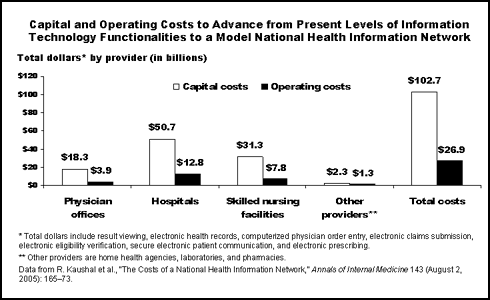While many industry experts agree that widespread use of information technology (IT) could greatly improve the safety, quality, and efficiency of U.S. health care, adoption remains slow, mainly due to the high cost barrier. But just how great are the costs involved?
According to a Commonwealth Fund–supported study, building a national health information network (NHIN) in five years would require $156 billion in capital investment, plus $48 billion in annual operating costs. Those amounts, while substantial, represent a fraction of current health care expenditures. In 2003, the United States spent 15 percent of gross domestic product, or $1.65 trillion, on health care, with costs continuing to increase each year.
In The Costs of a National Health Information Network, (Annals of Internal Medicine, August 2, 2005), a research team led by Rainu Kaushal, M.D., M.P.H., of Brigham and Women's Hospital in Boston, assessed the existing status of IT within the health system and then estimated what it would cost to create a model NHIN. The ideal network, as defined by the study, would include electronic health records (EHRs), secure electronic communication between patients and providers, electronic claims submissions and eligibility verification, the ability to view and share test results, computerized physician order entry (CPOE), and electronic prescribing.
Study Methods
The research team convened an expert panel of health care IT specialists from industry, academia, and government. Members included David Brailer, M.D., formerly of the Health Technology Center and currently the National Health Information Technology Coordinator at the U.S. Department of Health and Human Services; Lucian Leape, M.D., of the Harvard School of Public Health; and Janet Corrigan, Ph.D., of the Institute of Medicine, among others.
Using the best available data, the panel determined that an NHIN must have two components: 1) functionality, or the ability to perform key functions, such as CPOE, and 2) interoperability, or the capacity to link health care providers and exchange data. Assuming fixed prices for hardware and software and no major new technological developments, the panel then estimated the costs of both aspects of the system for a range of providers: physician offices, hospitals, skilled nursing facilities, home health agencies, clinical laboratories, payers, and pharmacies.
Key Findings
Total costs to achieve NHIN functionality in five years would be $103 billion in capital costs and $27 billion in annual operating costs, the study found. Interoperability costs would amount to $53 billion in capital investment and $21 billion in ongoing annual operating costs. The panel also projected expenditures over the next five years. Assuming no change in current IT spending, the health care industry will spend about one-quarter of the desired functionality costs ($24 billion), say the authors, and will probably not even begin to address issues of interoperability.
In the model NHIN, hospitals would incur the highest functionality costs ($51 billion), mainly driven by expensive electronic health record and CPOE systems that can cost millions of dollars per installation. Skilled nursing facilities would also incur high costs ($31 billion), primarily because they have little IT in place, as would office practices ($18 billion). Because costs for interoperability are associated with the number of providers, physician office practices would require the bulk of funds ($31 billion), followed by pharmacies ($10 billion), skilled nursing facilities ($5 billion), and hospitals ($2 billion).
Discussion
IT adoption rates have improved in recent years through various public policy initiatives. Standards for electronic health transactions established by the Health Insurance Portability and Accountability Act of 1996, for example, are largely responsible for high rates of automated claims submission. Other policy options are currently being considered as well, including bipartisan legislation that addresses both IT and an NHIN.
But as the authors point out, the private sector is unlikely to move rapidly in adoption of IT without public sector investment and incentives. Institutions tend to invest in areas that provide direct financial benefits, like new equipment or facilities; IT's benefits typically accrue to a broader range of players.
If the United States is to establish an NHIN within a reasonable timeframe, reimbursement policies will need to be revised, the authors say, so that financial incentives for IT adoption are better aligned.
Facts and Figures:
- In total, $156 billion in capital investment and $48 billion in annual operating costs would be required to achieve a model national health in-formation network in five years—a small portion of total health care spending.
- The health care sector overall will spend an estimated $24 billion over the next five years on various health information functionalities.
- The least expensive NHIN components are electronic prescribing, secure electronic communication with patients, and electronic claims submission.
